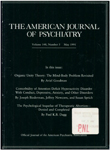Cyclothymic mood swings in the course of affective disorders and schizophrenia
Abstract
The authors assessed cyclothymic mood swings and psychosocial adjustment in 38 unipolar depressed, 27 bipolar, 35 schizophrenic, and 27 other psychiatric patients 4 years after hospital discharge and in 153 normal control subjects. The patients were significantly more cyclothymic at follow-up than the control subjects, but there were no differences in cyclothymia between the diagnostic groups. Cyclothymic patients showed significantly poorer posthospital functioning than noncyclothymic patients. These findings raise questions concerning the scope of the hypothesized cyclothymic-bipolar spectrum. Minor mood swings in a variety of patients with poor posthospital adjustment may reflect persistent vulnerability to psychopathology.
Access content
To read the fulltext, please use one of the options below to sign in or purchase access.- Personal login
- Institutional Login
- Sign in via OpenAthens
- Register for access
-
Please login/register if you wish to pair your device and check access availability.
Not a subscriber?
PsychiatryOnline subscription options offer access to the DSM-5 library, books, journals, CME, and patient resources. This all-in-one virtual library provides psychiatrists and mental health professionals with key resources for diagnosis, treatment, research, and professional development.
Need more help? PsychiatryOnline Customer Service may be reached by emailing [email protected] or by calling 800-368-5777 (in the U.S.) or 703-907-7322 (outside the U.S.).



